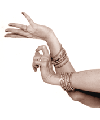Kay Poursine at far right showing hastas (hands) used in abhinaya or drama. Both hands are relaxed patakas showing playing a flute.
This combined hand position is one of many iconographic images symbolizing young Lord Krishna (an avatar or incarnation of Vishnu) as the cowherd while playing his flute. There are infinite number of ways to use hastas to create poetic imagery that extract the hidden meanings in dance bhakti (devotional) poetry.
Bharata Natyam is perhaps the oldest of the four major dance forms
of India. It is indigenous to Southern India (Tamilnad), particularly the
city of Madras (capital of Tamilnad). It is performed by a solo female
dancer who portrays all the characters in the performance, drawing from
the entire mythology of Hindu religion (see Avatars), philosophy,
 An introduction to a
traditional Bharata Natyam concert.
An introduction to a
traditional Bharata Natyam concert.
Literature, music (Carnatic, classical South Indian music), and dance in India are completely interdependent. Using
an old and rich language of hand gestures (hastas), the dancer interprets
a song chosen from the repertoire of south Indian dance compositions. The song
is a setting of poetic text within a rhythmic framework (talam) and
within a melodic mode (ragam) that fits the mood (bhava) of the text. The
dancer moves always in relation to the talam of the song, which
the singer "keeps" by means of a combination of finger counting, claps,
and waves; the dance master often keep the talam along with the singer,
using small hand cymbals.
 A brief history of Classical
Dance from South India
A brief history of Classical
Dance from South India
Copyright ©2001 Kay Poursine. ® All rights reserved ®